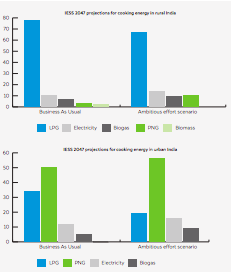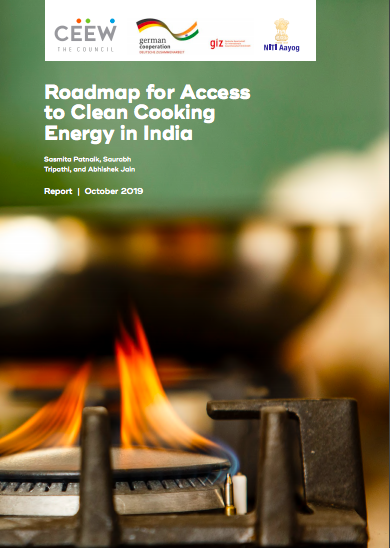Report
Roadmap for Access to Clean Cooking Energy in India
Sasmita Patnaik, Abhishek Jain
October 2019 |
Suggested citation: Patnaik, Sasmita, Saurabh Tripathi, and Abhishek Jain. 2019. Roadmap for Access to Clean Cooking Energy in India, New Delhi: Council on Energy, Environment and Water.
Overview
The Clean Cooking Energy Roadmap—developed in collaboration with NITI Aayog and GIZ— envisions to eliminate the use of all cooking arrangements that cause household air pollution (HAP) in India by 2025. It adopts a multi-fuel, multi-stakeholder approach, and is guided by principles of equity and inclusion. It calls for a neutral inter-ministerial commission to deliver on the recommendations and to monitor progress towards an HAP-free India. The Roadmap prescribes sectoral and fuel-specific strategies to transform the supply-side value chains of improved cookstoves, biogas, LPG, piped natural gas, and solar and electricity-based cooking. These strategies integrate technology and business model development, while also focusing on access to credit for both households and enterprises. The roadmap is an outcome of consultations with the representatives of key ministries facilitated by NITI Aayog and interviews with 30 key stakeholders in the cooking energy sector.
A 2018 survey by CEEW in six states of India—Bihar, Jharkhand, Madhya Pradesh, Odisha, Uttar Pradesh, and West Bengal—showed that only about one-third of rural population use LPG as their primary cooking fuel. With near universal coverage of LPG connections now within sight, the next policy challenge is to sustain the use of clean cooking energy, and to transition households away from the use of traditional fuels.

Source: NITI Aayog, forthcoming
Key Findings
- Sectoral strategies
- Improve awareness of households on the adverse health impacts of cooking using traditional fuels
- Assess the socio-economic and gender aspects of energy access
- Improve availability of data on the use of cooking energy
- Monitor and streamline subsidies to focus on subsidies for clean cooking energy rather than those for a particular fuel.
- Fuel-specific strategies
- Develop product or technology to provide safe and clean solutions that meet consumer needs: This includes investments in energy labelling for LPG stoves to improve efficiency and affordability for end-users, investments in research to reduce the cost of biogas bottling and packaging, investments in R&D to develop and test cookstoves to improve their design, efficiency and adequacy, etc.
- Develop business models that ensure regular fuel availability:This includes piloting enterprise-based models for biogas to ensure better management of the plants, piloting alternative distribution channels for LPG such as self-help groups (SHGs) to improve local availability, promoting pay-as-you-go technology to improve affordability of payments, etc.
- Strengthen the financial ecosystem to enable affordable access for sustained use:This includes providing low-interest loans for enterprises operating in remote areas with low-income groups, sensitising bank professionals about technologies to improve lending to enterprises in order to ease their working capital needs, etc.
- Develop a monitoring and evaluation framework that uses mixed methods to monitor clean fuel adoption and use, both regionally and nationally.
Stacking will be common among households transitioning to clean cooking energy, necessitating a multi-fuel approach.






